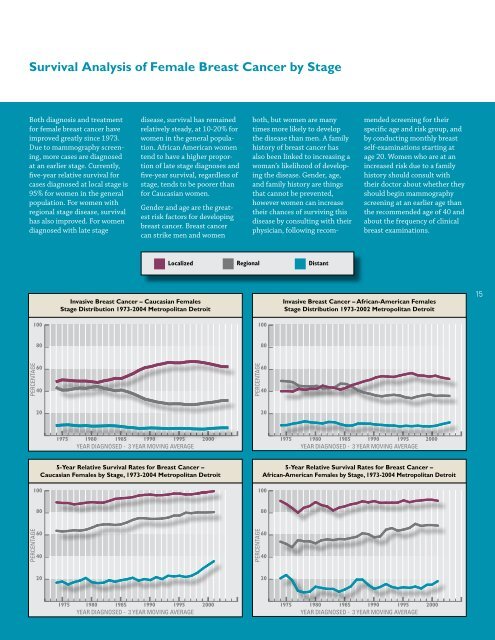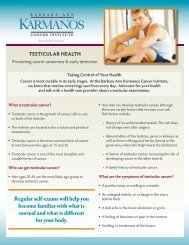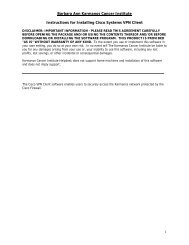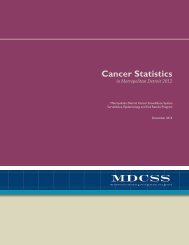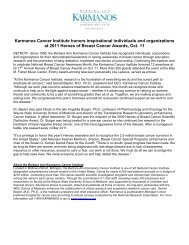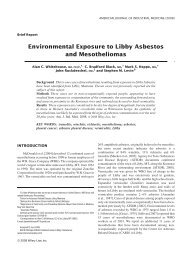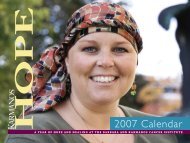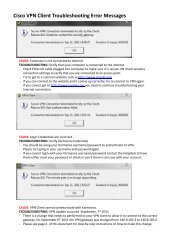Cancer Statistics - Karmanos Cancer Institute
Cancer Statistics - Karmanos Cancer Institute
Cancer Statistics - Karmanos Cancer Institute
Create successful ePaper yourself
Turn your PDF publications into a flip-book with our unique Google optimized e-Paper software.
Survival Analysis of Female Breast <strong>Cancer</strong> by Stage<br />
Both diagnosis and treatment<br />
for female breast cancer have<br />
improved greatly since 1973.<br />
Due to mammography screening,<br />
more cases are diagnosed<br />
at an earlier stage. Currently,<br />
five-year relative survival for<br />
cases diagnosed at local stage is<br />
95% for women in the general<br />
population. For women with<br />
regional stage disease, survival<br />
has also improved. For women<br />
diagnosed with late stage<br />
disease, survival has remained<br />
relatively steady, at 10-20% for<br />
women in the general population.<br />
African American women<br />
tend to have a higher proportion<br />
of late stage diagnoses and<br />
five-year survival, regardless of<br />
stage, tends to be poorer than<br />
for Caucasian women.<br />
Gender and age are the greatest<br />
risk factors for developing<br />
breast cancer. Breast cancer<br />
can strike men and women<br />
both, but women are many<br />
times more likely to develop<br />
the disease than men. A family<br />
history of breast cancer has<br />
also been linked to increasing a<br />
woman’s likelihood of developing<br />
the disease. Gender, age,<br />
and family history are things<br />
that cannot be prevented,<br />
however women can increase<br />
their chances of surviving this<br />
disease by consulting with their<br />
physician, following recommended<br />
screening for their<br />
specific age and risk group, and<br />
by conducting monthly breast<br />
self-examinations starting at<br />
age 20. Women who are at an<br />
increased risk due to a family<br />
history should consult with<br />
their doctor about whether they<br />
should begin mammography<br />
screening at an earlier age than<br />
the recommended age of 40 and<br />
about the frequency of clinical<br />
breast examinations.<br />
Localized<br />
Regional<br />
Distant<br />
100<br />
Invasive Breast <strong>Cancer</strong> – Caucasian Females<br />
Stage Distribution 1973-2004 Metropolitan Detroit<br />
Invasive Breast <strong>Cancer</strong> – African-American Females<br />
Stage Distribution 1973-2002 Metropolitan Detroit<br />
15<br />
100<br />
80<br />
100<br />
PERCENTAGE PERCENTAGE<br />
80<br />
60<br />
60<br />
40<br />
40<br />
20<br />
PERCENTAGE<br />
80<br />
60<br />
40<br />
20<br />
20<br />
1975 1980<br />
1985 1990 1995 2000<br />
1975<br />
1980 1985 1990 1995 2000<br />
YEAR DIAGNOSED - 3 YEAR MOVING AVERAGE<br />
1975 1980 1985 1990 1995 2000<br />
YEAR DIAGNOSED - 3 YEAR MOVING AVERAGE<br />
5-Year Relative Survival Rates for Breast <strong>Cancer</strong> –<br />
100Caucasian Females by Stage, 1973-2004 Metropolitan Detroit<br />
100<br />
80<br />
PERCENTAGE PERCENTAGE<br />
80<br />
60<br />
60<br />
40<br />
40<br />
20<br />
PERCENTAGE<br />
5-Year Relative Survival Rates for Breast <strong>Cancer</strong> –<br />
African-American Females by Stage, 1973-2004 Metropolitan Detroit<br />
100<br />
80<br />
60<br />
40<br />
20<br />
20<br />
1975 1980<br />
1985 1990 1995 2000<br />
1975<br />
1980 1985 1990 1995 2000<br />
YEAR DIAGNOSED - 3 YEAR MOVING AVERAGE<br />
1975 1980 1985 1990 1995 2000<br />
YEAR DIAGNOSED - 3 YEAR MOVING AVERAGE


